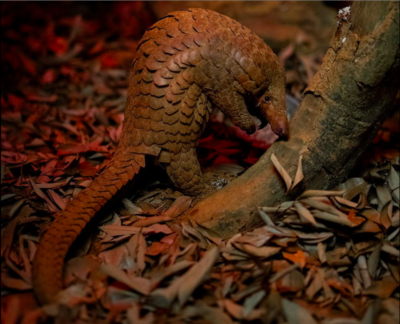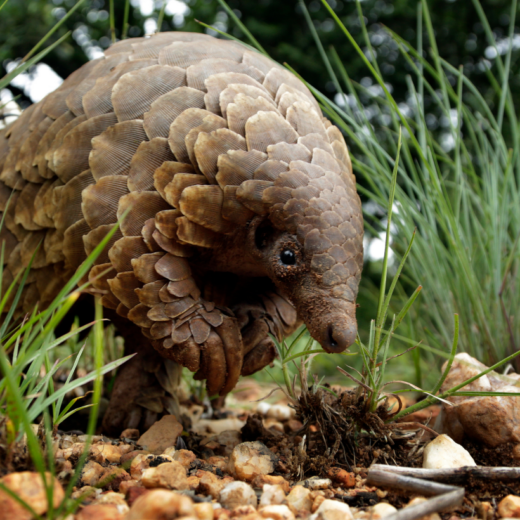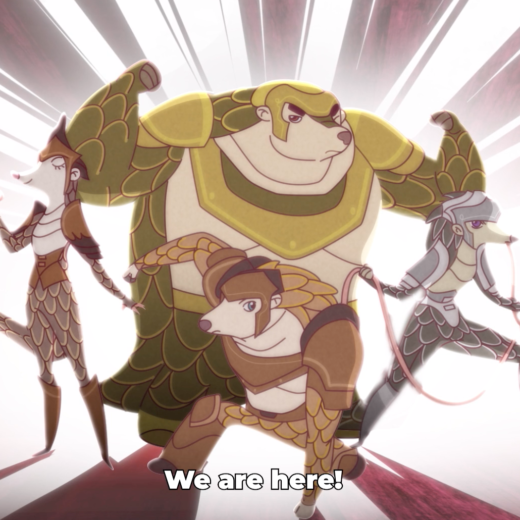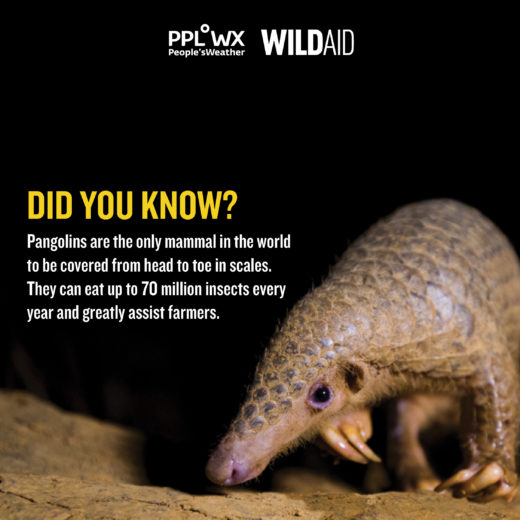
![]()
![]()
By Matthew Campbell
In November, customs agents at Hong Kong International Airport spotted something unusual as they X-rayed the baggage of a Chinese man who’d just arrived from Ethiopia. They told the passenger, 44-year-old Lin Jin-Bao, he’d have to open his suitcases before being allowed to board a ferry to his next destination, Macau. Inside, the agents found 24 tightly packed aluminum foil pouches. Each was filled with hundreds of mottled, brownish-red flakes—some shaped like jagged circles, others resembling tiny spades.
Lin was swiftly arrested. The suitcases contained 48 kilograms (106 pounds) of pangolin scales, a once-obscure commodity that’s become wearily familiar to law enforcement agencies in Asian hubs. The pangolin, one of the only scaly mammals known to science, looks a little like a large gecko crossed with an artichoke. It’s now believed to be among the world’s most trafficked animals, the victim of aggressive poaching operations set up to serve demand for its scales, which are considered by some practitioners of Chinese and Vietnamese traditional medicine to have healing properties, and its meat—a status symbol in Vietnam.
Lin, whose cargo had an estimated street value of HK$189,000 ($24,100), pleaded guilty to importing a protected wildlife product without a license and received a 20-month jail sentence. He was small fry in an illicit industry that might be worth billions of dollars, but rare for being convicted. In April customs officers at a Singapore port terminal inspected a shipping container purportedly full of frozen beef from Nigeria and found just under 13 tons of scales, with a value they estimated at about $39 million. Less than a week later they pulled a similarly sized haul from a container that was supposed to contain seeds from the cassia plant. That many scales would have likely required the deaths of some 21,000 pangolins.
Trafficking experts point out with alarm that these seizures are indicative of an enormous global trade along a sophisticated network, reaching from poachers in Central Africa to smugglers in Nigeria to middlemen across Asia to consumers in China and Vietnam. Even optimistic wildlife activists concede that they’re late to the problem. Until recently, they tended to focus on contraband from what are known in conservation circles as charismatic megafauna: species, such as elephants and rhinos, whose photogenic quality and symbolic import make drumming up public support and donor dollars comparatively easy. Only in the past decade did the rise in pangolin trafficking become apparent—a consequence of rising prosperity in consuming countries and, perhaps, poachers switching opportunistically as other species grew more difficult to trade.
“The number of animals being stripped from the wild is completely out of control,” says John Scanlon, a former secretary-general of Cites, the main international organization for regulating trade in endangered species. “I fear they’ll be wiped out before we’ve adequately responded.”
Pangolins are a low-key marvel of the natural world. There are eight known species, with a geographic range that covers India, Southeast Asia, southern China, and much of sub-Saharan Africa. Most are nocturnal; all are toothless, relying instead on sticky, muscular tongues that can extend as long as their body. Most of the time, the appendage lies dormant in an internal sheath. When required, it can shoot deep into ant and termite nests with lethal speed and force, conjuring scenes of Lovecraftian horror. Pangolins also have claws that are well-adapted to digging for prey as well as specialized muscles that seal their ears and nostrils against incursion by insects. They’re myrmecophagous Terminators, each capable of killing, by one estimate, as many as 70 million bugs a year.
Shy and typically solitary, pangolins can be found in a variety of habitats, with some species preferring to burrow and others fond of climbing trees, sometimes using their muscular tails for balance. Females typically give birth to a single offspring, after a gestation of several months or more, and each infant requires significant maternal investment. Until a juvenile pangolin is mature enough to fend for itself, it rides atop its mother’s tail as she forages for food.
Evolution’s other great gift to the pangolin is, tragically, its main attraction for poachers: its scales, a robust armor of keratin, the same material responsible for human fingernails and rhino horns. When a pangolin is threatened or startled, its main defense is to curl into a ball, hiding its soft underbelly (and, if necessary, an accompanying infant) inside this jagged thicket. YouTube clips show hungry lions reduced to helpless incomprehension when an appealing-looking snack suddenly turns rock hard, impervious to tooth or claw. Unfortunately for the pangolin, though, it reacts the same way to humans, who can simply deposit a frightened victim into a sack like a beach ball.
Pangolins have proved difficult to track and count, making it hard to gauge how steeply their populations have declined. Their preference for trees and burrows makes them easily missed by camera traps, and unlike with other mammals, their eyes don’t readily shine in the glow of a flashlight. One of the more comprehensive efforts to quantify pangolin poaching, a 2017 study by a group of researchers from the University of Sussex and other institutions, produced only a very broad estimate that 400,000 to 2.7 million of the animals are hunted annually in Central Africa. Scientists don’t need a precise count, though, to conclude that the pangolin is in serious trouble. The International Union for Conservation of Nature classifies the Chinese pangolin and the Sunda pangolin of Southeast Asia as critically endangered; of the other six species, two are listed as endangered and the remainder as vulnerable.
Poachers succeed where researchers struggle because they can sprinkle hundreds or even thousands of snares around a known habitat. Another reliable tactic is sniffer dogs, which can be adept at finding pangolins even in their burrows. Hunters go to these lengths because pangolin farming is universally regarded as nonviable. The animals reproduce slowly and unmanageably, and they’re too easily stressed and susceptible to illness.
The major source countries are thought to include Cameroon, the Central African Republic, and Congo. As best as investigators can tell, much of the poaching takes place at relatively small scale, with loads consolidated into gargantuan cargoes by middlemen en route to port cities such as Lagos. One indicator of the smugglers’ power: Cites considers shipments of elephant ivory larger than 500 kilograms to indicate the involvement of organized crime, a small fraction of the size of some pangolin-scale seizures. The best guess, according to Richard Thomas of Traffic, a U.K.-based organization that monitors the wildlife trade, is that the culprits are “organized Asian criminal syndicates who must have a pretty extraordinary sourcing network.”
For the most part, it’s just a guess. Prosecutions of smugglers are much rarer than seizures of their wares, and no law enforcement agency has come close to identifying the Cali cartel of pangolin trafficking. And just as with drugs, there’s every reason to believe that as long as demand for scales and meat persists, so too will illicit efforts to meet it.
Lan Ong Street, in Hanoi’s Old Quarter, is the traditional-medicine capital of Vietnam, a stretch of dark, narrow shops packed into the ground floors of crowded tenements. The vendors sell a panoply of natural remedies: cordyceps mushroom for impotence, ginseng for stress, morinda root for joint pain. Not long ago, they would have displayed pangolin scales, which were sold more or less openly for arthritis and asthma and as an aid to lactation. Now the scales are gone, or at least hidden; on a recent visit, five Lan Ong shopkeepers said they no longer sold pangolin products for fear of punishment. Since 2017 Vietnam has imposed stiff penalties for selling the animal, in keeping with a trade ban accepted by the 182 nations that are party to Cites.
The moratorium on international trade doesn’t extend to sales within countries. Scales remain legal in China, though officially at least they must be drawn from an existing state-administered stockpile—a sort of Strategic Pangolin Reserve. Activists have doubts about how thoroughly this requirement is enforced and worry that smuggled scales are being used to replenish the stockpile.
Pangolin scales have been used in Chinese medicine since at least the 16th century. Until relatively recently, the demand could be met by small-scale poaching of local populations. “What we’ve seen in recent years is growing prosperity in those regions, which is a good thing, but it does mean they’re able to afford things that were previously unobtainable,” Thomas says.
Persuading Chinese and Vietnamese consumers to give up pangolin will be the work of many years. A survey by the charity WildAid of 3,000 Chinese city dwellers in 2017 found that 50% believed pangolin products have medicinal value. (They almost certainly don’t: You’ll get as much benefit from eating your fingernails.) Despite their uselessness, scales remain listed in the official pharmacopeia issued by China’s health regulator, and according to WildAid more than 60 drugs approved in the country contain pangolin products, indicated for conditions such as swelling, hemorrhoids, tight muscles, and poor circulation. The next edition of the pharmacopeia is due in 2020, and activists hope the scales will be removed from that version or a subsequent one, as rhino horn and tiger bone were in the 1990s.
Environmental organizations are doing what they can to educate the public. WildAid and the Nature Conservancyhave commissioned ads featuring the Chinese actress Angelababy, as well as an adorable one starring Jackie Chanas kung fu instructor to a trio of CGI pangolins. WildAid has also deployed educational videos in Vietnamese shopping centers and airports and convened Chinese medicine experts for seminars on alternatives to scales.
Stamping out demand entirely could prove impossible, though. Ad campaigns discouraging consumption of rhino horn and elephant ivory for more than a decade have seen some success, but neither trade is close to disappearing. A recent study by Traffic showed that ivory jewelry was still readily available in Vietnam’s stores and social media channels, while another survey of the country, commissioned by the U.S. Agency for International Development, reported that 6% of respondents had purchased rhino products in the preceding year.
At Cuc Phuong National Park, a sweltering nature preserve in northern Vietnam, a group of veterinarians, zoologists, and volunteers is working to rehabilitate pangolins confiscated from trafficking operations and to help revive the country’s population. Save Vietnam’s Wildlife (SVW) was founded in 2014 by Nguyen Van Thai, a conservationist who’d been working with pangolins in the park for nearly a decade. It has about 40 to 50 of the animals on-site at a time, many of which arrived dehydrated, malnourished, and traumatized.
Pangolin gourmands prefer the meat be freshly killed, as with lobsters, so busts—conducted by the Vietnamese authorities with increasing frequency—often turn up live animals. Some come from as far away as Borneo. The conditions of their carriage are appalling, with pangolins sometimes confined in shipping containers, marinating in their own waste. Others have been force-fed to fatten them up. Serving pangolin meat, Nguyen complains, still “is seen as a way to impress someone with something rare, something special.”
After they arrive at SVW, pangolins spend 30 days under quarantine in concrete-enclosed pens. They may require urgent medical care: rehydration therapy, often, and sometimes the removal of eyes damaged by malnutrition or the amputation of limbs or tails wounded by snares. Next to the door of each pen, a dry-erase board lists the occupant’s date of arrival, identification number, and health issues such as cloudy eyes or lingering wounds. On one, the problem is listed as simply “stress.”
The worst-off animals spend time in an intensive-care unit, tended by a team of veterinarians whose pangolin expertise is evolving, to say the least. “We do a lot of MacGyvering. You have to make things work,” says Jessica Jimerson, who came over from the Houston Zoo to manage SVW’s veterinary clinic; her right bicep features an impressively detailed tattoo of a balled-up pangolin. Jimerson recently performed the clinic’s first pangolin blood transfusion, drawing from a strapping male specimen to aid a female on the verge of death. That procedure was a success, but not every patient can be saved. “We’re so far behind the eight ball by the time we get them,” she says.
The healthy pangolins at SVW while away their days in special sleeping cubbies with narrow apertures, a design intended to mimic the pitch-black conditions of a burrow. At night they’re fed a dish of frozen ant eggs, placed just inside the doors of the spacious enclosures they roam while awake. Within a few moments they emerge from deep inside their pens, positioning themselves above the bowl and hoovering up the meal with methodical strokes of their tongues. After that they’re left to explore the tree trunks and branches threaded through their living areas. Staff sometimes hide “enrichment toys”—bamboo pole lengths stuffed with ants, covered at each end with a disguise of leaves. The idea is to get the residents sniffing for meals to revive their foraging instinct for when they’re released back into the wild. They typically stay at SVW for a couple of months before that happens.
Nguyen’s operation is something of a conservation showpiece, supported by Sydney’s Taronga Zoo, the U.S. Fish and Wildlife Service, and Humane Society International. Funding is easier to come by than it once was, with the pangolin marching up the list of conservation priorities. “Before a few years ago, when I went to North America or Europe to talk about pangolins, people thought I meant penguins,” Nguyen says with a laugh.
The work is still arduous and its success difficult to measure. SVW has rescued more than 1,000 pangolins and returned the majority to the wild; how they fare afterward is hard to know. Nguyen’s goals are necessarily modest. “We’re trying to slow the speed of the decline, and hopefully in the next few years we can stop the decline and start a recovery,” he says. “We still believe the things we do can make a difference.” —With Giang Nguyen and Daniela Wei
Stay in touch and get the latest WildAid updates.
SIGN UP


